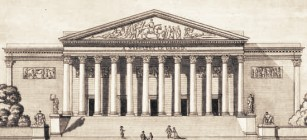 List of members of the Corps Législatif.
List of members of the Corps Législatif.
The Legislative Body (in French Corps Législatif) was created by the Constitution of 22 Frimaire, An VIII, and remained in existence during the Consulate and Empire. The assembly sat in the Palais Bourbon (then called the Palais du Corps Législatif), previously occupied by the Conseil des Cinq-Cents. Between 1806 and 1810, under the direction of architect Bernard Poyet (1742-1824), the building was given the facade we know today. The first session took place on 11 nivôse an VIII (January 1, 1800).

Members of Parliament
The Corps Législatif comprised 300 members elected for a five-year term. It was renewable by fifths each year, and its members were ineligible for one year after leaving office (an exclusion lifted under the Empire).
During the Consulate, members of the Corps Législatif were appointed according to a complex system that amounted, in total, to a four-stage election by universal male suffrage. In each commune, all adult males aged at least 21 elected a list of confidence made up of one tenth of their number. The process was repeated at departmental and then national level, culminating in a national list of trust comprising one adult man in a thousand, i.e. around six thousand names. From this list, the Conservative Senate selected the members of the Legislative Body from among elected representatives aged thirty and over. Each department had to have at least one representative.
The Senatus-consulte of 16 Thermidor Year XII modified the operations prior to the Senate's choices. It instituted a canton assembly comprising all citizens domiciled in the canton. This assembly designated two electoral colleges: one for the arrondissement, with a number of members proportional to the numerical size of the assembly, where all citizens were eligible; and one for the department, with a membership one-thousandth that of the department, where only the six hundred highest taxpayers were eligible. College members were elected for life.
Each college nominated two citizens domiciled in the department − one of whom was not be a member of the college − to the list from which deputies to the Corps Législatif were chosen. Each department was now represented by a number of deputies proportional to its population.
The first elections took place on 4 nivôse an VIII (December 25, 1800).
Missions of the Corps législatif
The role of this assembly was exclusively legislative: it approved or rejected, but did not debate, the laws presented to it after they have been examined by the Tribunate.
The powers of the Corps Législatif increased following the abolition of the Tribunat (1807). Three seven-member commissions were set up to examine draft legislation. They were also responsible for discussing and presenting them to the assembly, which was always condemned to remain silent.
Behavior
Like the Senate, the Corps Législatif demonstrated a rare servility during the Consulate and Empire. This did not prevent Napoleon 1st from mistrusting them. He suspected that the legislators, many of whom were former revolutionaries, still saw themselves as the National Assembly.
The Corps Législatif was dissolved on June 4, 1814, after the fall of the First French Empire.